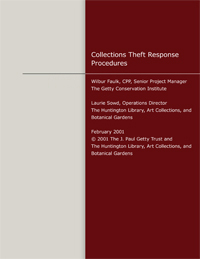Wilbur Faulk and Laurie Sowd; 2001
The theft and illicit trade of cultural artifacts is a major international crime, second only to drug trade, and totaling $4-6 billion each year (according to the Museum Security Network). A vast majority of those thefts are committed by someone inside the cultural organization. Few have personal experience with collections theft, so these Collections Theft Response Procedures were created to provide guidance to the multiple functions involved in theft response, and to suggest actions to take before and after the incident. The procedures are designed for use by all cultural property organizations (museums, libraries, archives) of any size. They are not intended to be comprehensive, but to highlight issues and provide a sense of the process. Responding to a theft is like responding to a human-caused or natural disaster. The Collections Theft Response Procedures attempt to mirror the structure already in place for emergency response. They identify functions that need to be performed in responding to a theft—about 7 roles from within your organization and about 4 that are likely to be filled by people outside your institution with whom you maintain close ties. In addition to the checklist for each function, guidelines on preventative measures, reporting a theft, recording information about objects, and current law are provided. On the last page, you will find a suggestion of the primary steps to take following a theft. How to Cite this WorkFaulk, Wilbur, and Laurie Sowd. 2001. Collections Theft Response Procedures. Los Angeles, CA; San Marino, CA: Getty Conservation Institute; Huntington Library. http://hdl.handle.net/10020/gci_pubs/collections_theft_response | ||||||
|
|
|||||||||||
